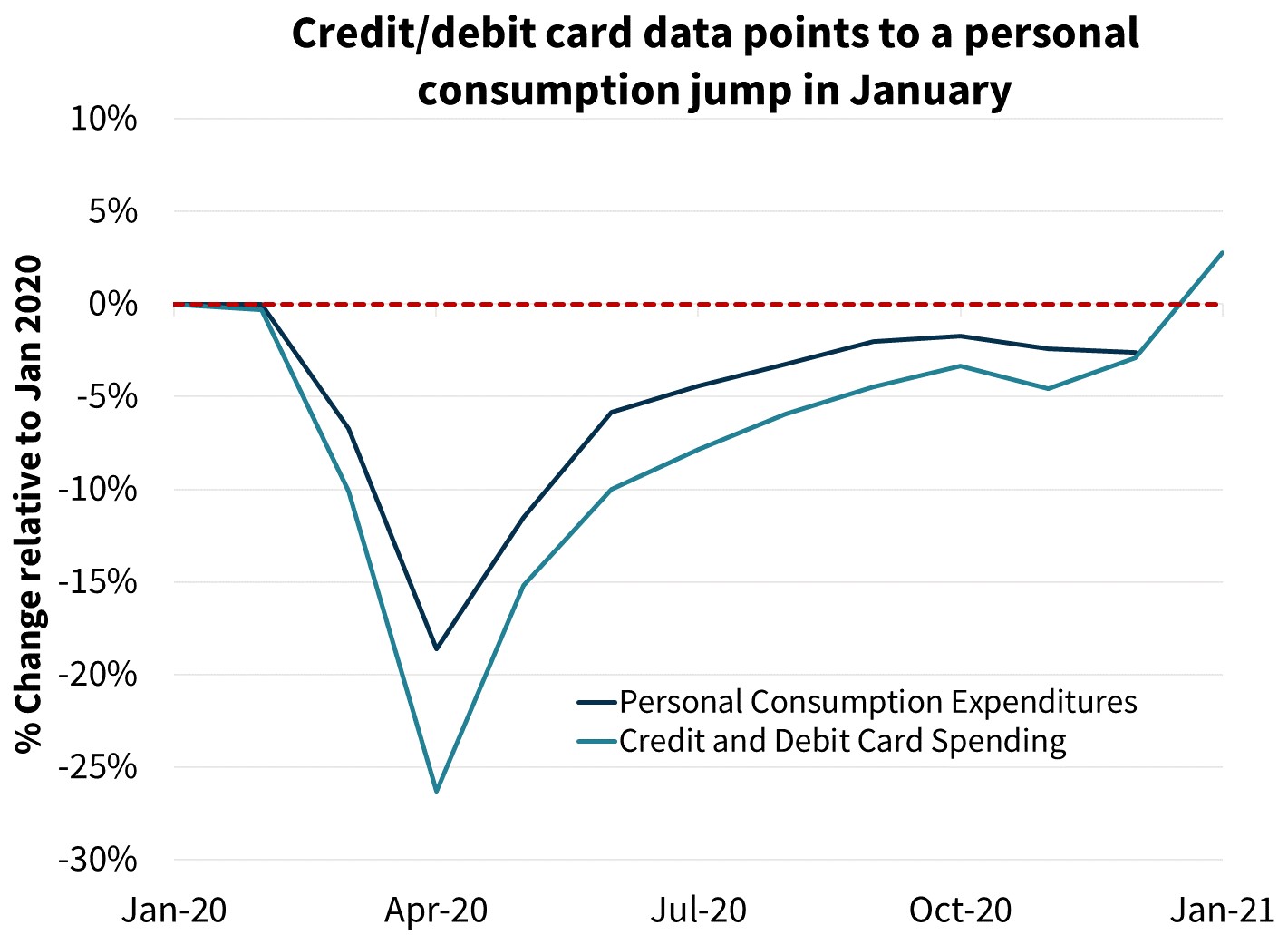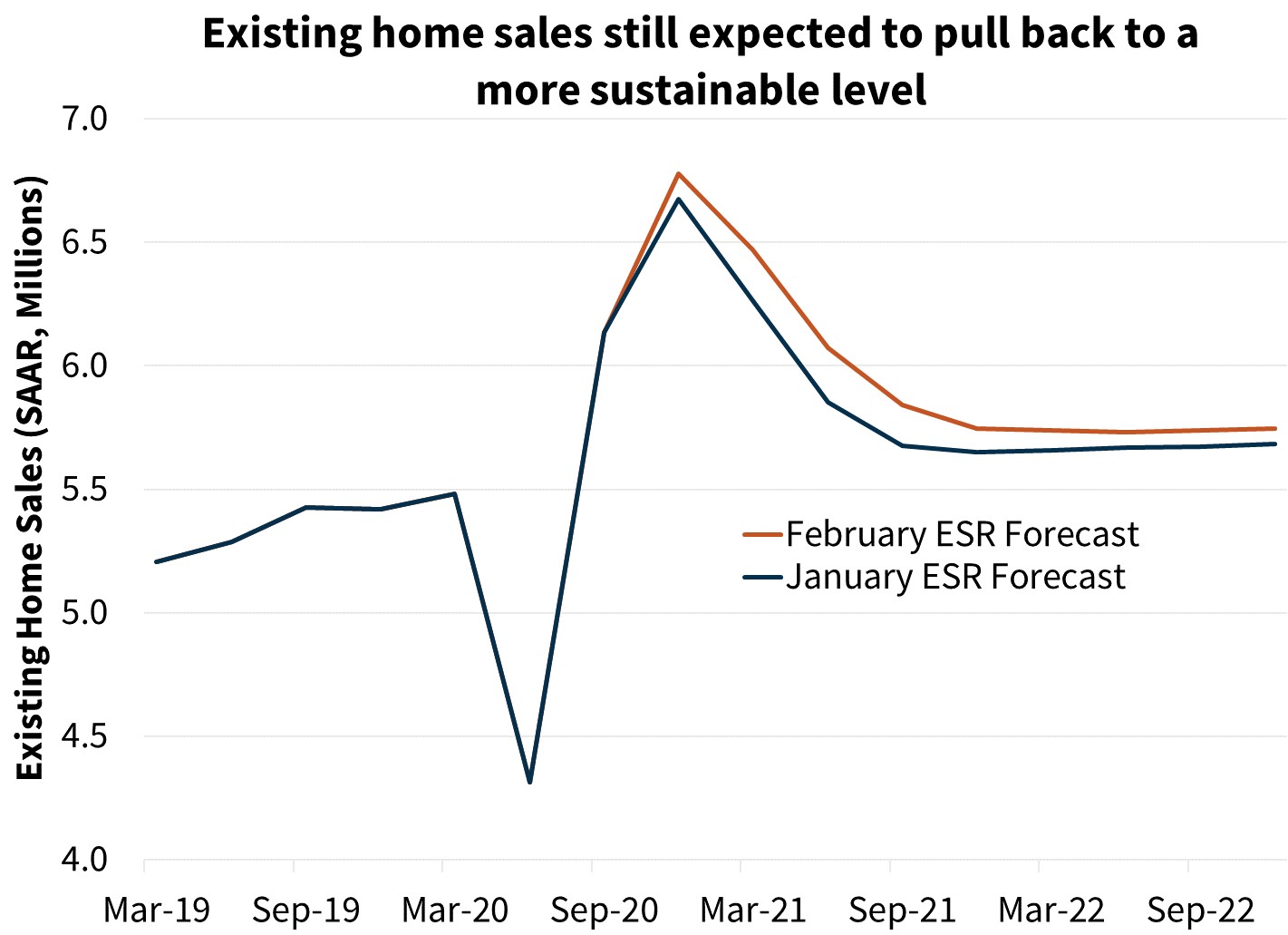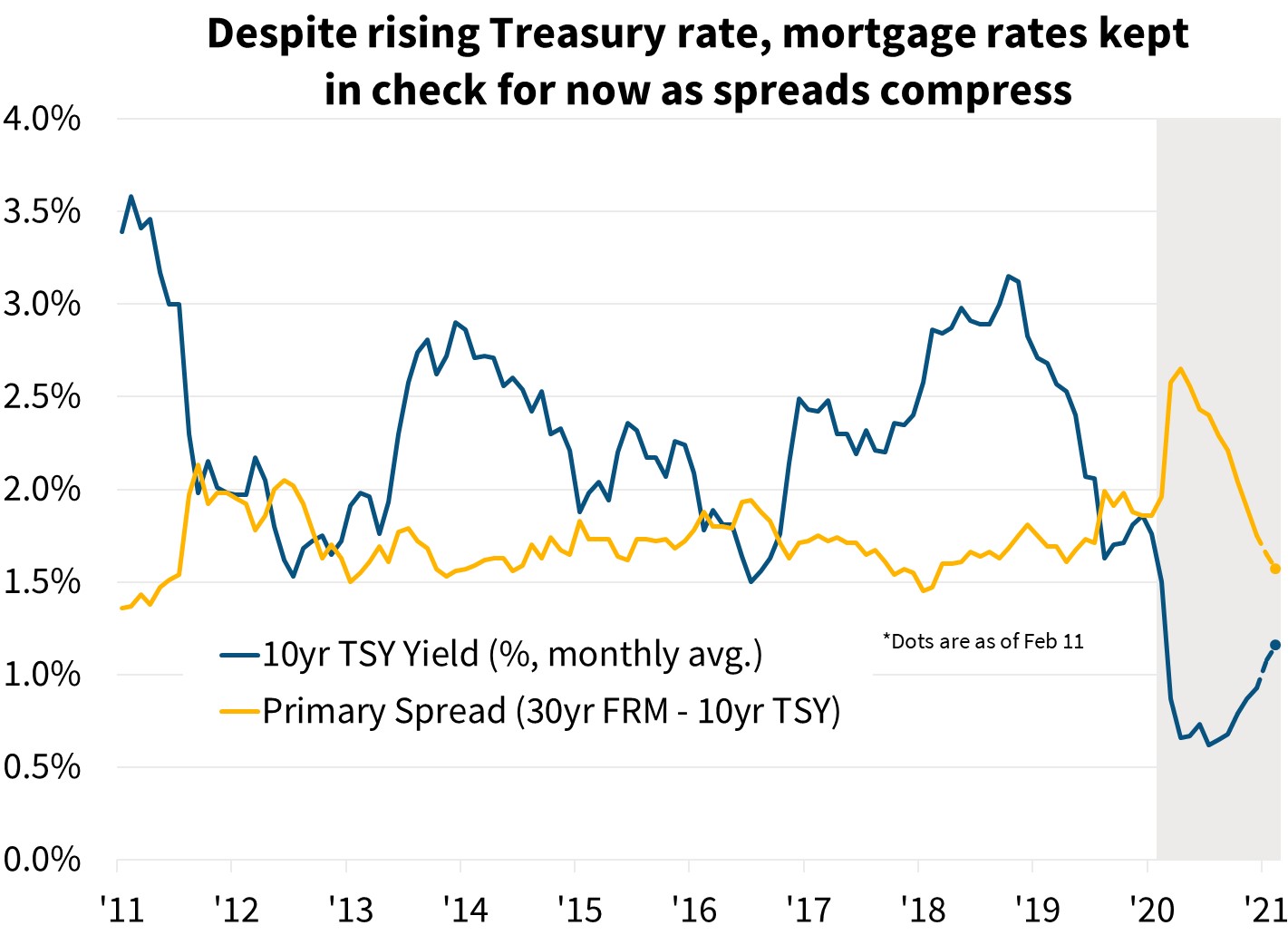Fiscal Stimulus, Successful Vaccine Deployment Likely to Boost Growth but Also Pose Inflationary Risk
Recent data point to more resilient consumer spending over the winter months than previously expected. Simultaneously, the ongoing COVID-19 vaccination effort has coincided with a swift decline in cases and hospitalizations in recent weeks, along with some loosening of state-level distancing measures. Combined with an updated assumption of a roughly $1.7 trillion stimulus package being passed by mid-March, we upgraded our full-year forecast for real gross domestic product (GDP) growth in 2021 to 6.7 percent from 5.3 percent, on a Q4/Q4 basis. If realized, this would be the fastest annual growth rate since 1983. Some of this more robust growth, however, comes via bringing forward the expected timing of the recovery. Therefore, our forecast for full-year 2022 growth was revised downward to 2.8 percent from 3.6 percent. Still, this combined change leaves our end-of-year projection for 2022 GDP 0.8 percentage points higher than in our prior forecast. However, with this updated assumption on fiscal policy, and a faster expected pace of growth, risks of stronger inflation and rising interest rates have grown.
While we still expect home sales to trend downward from the current level following the torrid pace of the back-half of 2020, we revised upward our sales forecast for 2021. We now expect total home sales to rise 6.9 percent over the year compared to our previous forecast of 3.8 percent. This revision is largely due to recent incoming data suggesting that the anticipated cooling in the sales pace over coming months will take somewhat longer than previously anticipated. Additionally, our forecast for single-family starts is for an increase of 18.6 percent in 2021, up from our previous forecast of 12.5 percent, which should support sales. Consistent with this upgraded housing forecast, as well as incoming refinancing data, we upgraded our mortgage originations forecast for 2021 to $4.1 trillion, up from $3.9 trillion previously. However, due to a modestly higher interest rate forecast, we revised downward slightly our 2022 originations expectations by $43 billion to $3.2 trillion.
Rolling Set of Risks Going Forward
Even with quickly declining COVID-19 cases, uncertainty around the forecast remains high. In the short run, the primary risk is around the assumption that between ongoing vaccinations and warmer weather the bulk of remaining restrictions will be lifted starting in the spring. However, if vaccines prove to be ineffective for evolving strains of the disease, consumers and firms are reluctant to return to currently limited activities, or state and local governments maintain significant restrictions, growth could potentially be much weaker than we expect. Alternatively, consumers have built up over $1.5 trillion in “excess savings” over the past year, providing potential consumer spending power; the proposed stimulus bill will only further bolster the current unprecedented fiscal support. If virus-related conditions improve as expected and pent-up consumer demand can be realized, then growth has the potential to be even stronger over the second and third quarters than we are currently forecasting. Looking further down the road, if a brisk recovery occurs, the larger risks for our forecast, include greater upward pressure on inflation and interest rates than we currently forecast. A more robust upward movement in interest rates could: stymie growth later this year and into 2022; lead to varying degrees of asset repricing depending on their duration and the extent of speculative activity to date; and would likely be a significant drag on the pace of home sales and mortgage originations.
Recent Data Point to a Stronger-than-Expected Winter
Coinciding with quickly declining COVID-19 cases and the loosening of some restrictions, consumer spending appears to have been stronger in January than we previously anticipated. While COVID-related social distancing remains a drag on growth, high frequency credit and debit card data show a significant boost in purchases in January, likely in part due to distribution of the last round of stimulus checks. While some of this spending boost would therefore be temporary, combined with other measures such as auto sales increasing 2.6 percent in January, restaurant reservations picking up, and oil refinery utilization rates rising, a picture of a more resilient consumer has emerged to start off the year. Additionally, colder than usual temperatures in recent weeks will likely lead to an increased level of household utility spending, boosting personal consumption expenditures in the first quarter.

January’s payroll report showed a gain of only 49,000 jobs, the second month in a row with a weak topline number. However, labor markets are usually lagging indicators and the pace of initial unemployment claims resumed its decline in late January and early February. We expect the soft patch in employment to be near an end. Moving into the spring, we forecast a large acceleration in payroll growth, in large part reflecting the opening of additional food service, hospitality, and entertainment activities.
Our Thinking Around the Next Stimulus Bill
We now assume the passing of a new round of fiscal stimulus of about $1.7 trillion, somewhat smaller than the proposed $1.9 trillion. This reflects some assumed trimming to secure final bill passage. However, because the primary item of contention is the paring back of transfer payments to higher income households with comparatively low propensities to spend in the short run, the topline difference between the two bill amounts is minimal for GDP growth. In prior forecasts, given the then-greater legislative uncertainty, we assumed only that the unemployment benefit components of this package would be extended. This change in our assumptions translates to an additional $1.4 trillion of fiscal support over the next 12 to 18 months or so, relative to last month’s forecast.
Combined with previous bills, this next round of stimulus would mean the aggregate, explicitly COVID-related fiscal policy response will total nearly $5 trillion, or about 23 percent of pre-COVID annual GDP. This is a deficit expansion only rivaled by the World War II period. Limiting the view to just the recently passed $900 billion dollar bill in December plus the $1.7 trillion bill that we are assuming, would mean fiscal stimulus is approximately 12 percent of GDP (13 percent if the full $1.9 trillion passes). By comparison, economic output at the end of Q4 was down by 2.5 percent from peak, and about 4.5 percent from where output would have been if the pre-COVID growth trend had continued. This is to say that the fiscal support that is expected to be delivered this year will be multiple times larger than the remaining productive slack in the economy.
Traditionally, fiscal stimulus has been targeted to be some amount smaller than the expected remaining size of recovery. The theory being that fiscal stimulus “primes the pump”, whereas the initial deficit-financed spending or tax cut leads to higher incomes and employment, and that in turn drives further iterations of higher private sector spending and investment. In the current case, this is before considering that households also have a very large built-up stock of savings from the past year, which could also drive growth after additional COVID-related restrictions are lifted. In fact, as we have discussed in prior commentaries, we have for many months believed that even without additional stimulus (except for continuing unemployment benefits) the economy was poised to rebound quickly after COVID was no longer a drag.
Given the level of private savings and fiscal stimulus, as well as our assumption that the impact of COVID on consumer behavior will continue to wane, we are forecasting that the economy will “run hot” moving into 2022. By this we mean an output level that is above a sustainable growth path and consistent with stronger inflation. The Congressional Budget Office (CBO) recently released an update of its estimate for this sustainable “potential GDP” threshold. If the CBO is roughly correct, then it implies some combination of: 1) On a per-dollar basis, this next stimulus bill will have a weak aggregate effect on growth; and 2) the economy is going to operate well above potential. Our baseline forecast projects an output level in 2022 that would exceed the CBO’s potential estimate by about 2.2 percent (a similar gap last seen in the late 1990s), which would coincide with some modestly growing inflation. This “overshoot”, however, would fall short of the inflation-accelerating periods of the 1970s.

However, given its size, even with our projected GDP path that exceeds this potential estimate, our forecast implies that much of this new fiscal support will result in a greater stock of household savings rather than stimulating consumption demand. This would likely also help to fuel further financial asset appreciation. However, if growth were to move higher than we are currently forecasting due to a larger degree of consumption spending, it would suggest stronger inflationary pressures building over our forecast time horizon and perhaps a sharper rise in interest rates due to the likelihood that the Fed would then begin tightening. Furthermore, while the economy often does operate above the CBO’s estimated potential level (it was modestly above in 2019), it usually does so only slightly – and historically it has not done so for long. In the past, once it exceeded this potential level, the next recession occurred within four years in every case since 1970. In short, as we discussed in our commentary last month, we believe there to be significant risk of a short-lived business cycle over the coming years, and that the Fed may end up having to act more quickly than is currently assumed, or more forcefully down the road.
While We Wait to See, the Fed is On Hold
The Federal Open Market Committee (FOMC) meeting on January 26-27 featured no real surprises. The post-meeting statement showed that the FOMC decided to keep the federal funds rate unchanged at the zero-lower bound and would continue its asset purchases at the same pace of $80 billion Treasuries and $40 billion mortgage-backed securities per month. Chairman Powell indicated in his post-meeting comments that the FOMC sees no reason to taper asset purchases or change the federal funds rate any time soon. He also reiterated that the course of the virus and vaccination efforts are key to the economic recovery and encouraged people to get inoculated as quickly as possible. Powell stated that the Fed is expecting to see some inflation over the next year, but it will be minor and largely transitory due to the prior years’ shutdown-related base comparisons, so he welcomes it as it will help the Fed reach its long-run average inflation target of 2.0 percent.

Housing Strength Continues but Showing Signs of Pullback
Existing home sales surprised to the upside again in December, rising 0.7 percent over the month. However pending home sales, which lead closings by 30 to 45 days on average, slipped for the fourth consecutive month, falling 0.3 percent. The recent divergence in these measures is somewhat greater than usual and suggests a likely convergence in coming months. When combined with the continued decline in the relative supply of homes for sale, at a record low of 1.9 months of sales in December, and the slow pace of weekly new listings so far this year (down from a year prior), we believe it’s likely that existing sales will fall modestly over the next couple months. Still, the pace of deceleration continued to be slower than we had forecast. We therefore upgraded our forecast for existing sales for the year to 6.0 million, up 2.9 percent from last month.
While 2021 total sales are expected to be greater than in 2020, the pace going forward is still forecast to soften in coming months, reflecting the unsustainable sales pace in the second half of 2020 due in large part to a delayed spring homebuying season. We still expect sales to remain strong going forward, but they will likely converge back to a more sustainable trend moving into this year’s homebuying season. Our outlook, however, is dependent on mortgage rates remaining subdued. The rapid increase in home prices seen over the past year, up 11.0 percent in November per the FHFA Purchase-Only House Price Index, offsets most of the affordability gains from lower rates. Using the 30-year mortgage rate and the median existing home sales price, the estimated typical monthly housing payment in December was similar to that of the year prior. If mortgage rates were to move significantly higher, then home sales and house prices could quickly dampen, particularly in more expensive regions.
New home sales ticked up 1.6 percent in December after falling for the prior four months. We interpret this comparatively weak sales pace as being largely driven by the lack of new homes available for sale. In contrast, a lack of existing homes for sale and heightened interest in suburban locations is driving demand for new homes. As we’ve discussed previously, new home sales rose above their standard relationship to construction during the past year, and homebuilders are now catching up. We therefore do not believe the weakness in new home sales at the end of 2020 represented a strong drop-off in demand; purchase mortgage application activity has remained strong. Furthermore, new single-family housing starts jumped 12.0 percent in December to the highest annualized pace since September 2006. While a modest level of pullback is expected, we forecast single-family starts to continue their relative strength compared to new sales, as homebuilders restock their inventories.
In contrast, multifamily construction is expected to remain comparatively subdued. While interest in suburban multifamily projects and some smaller metros will likely remain strong, we expect weaker interest in new large, urban projects until there is greater clarity regarding work-from-home arrangements and urban migration patterns post- COVID, keeping total multifamily construction from picking up until 2022.
For more on multifamily market conditions please see the February 2021 Multifamily Market Commentary.
Mortgage Spreads Fall Below Long-Run Average
We have upgraded our forecast for 2021 purchase mortgage originations this month, in line with our improved outlook for existing home sales and new construction. Purchase volumes are now expected to total $1.8 trillion in 2021, an upward revision of $60 billion from last month’s forecast. However, we expect purchase volumes to fall 1 percent in 2022, coinciding with a softening annual pace of sales.
We expect refinance origination volume in 2021 to be $2.2 trillion, a 4 percent increase from last month’s forecast. Strong incoming application data and securitization volume suggest to us that the current refinance boom will continue for some time. Our projection for 2022 refinance volumes is just under $1.4 trillion, $62 billion lower than in last month’s forecast, as we now expect interest rates to rise faster than we had previously forecast. Still, at current interest rates, we estimate that 65 percent of outstanding mortgage balances have at least a half-percentage point incentive to refinance. This share is expected to shrink gradually as mortgage rates rise from their recent historic low.

Mortgage rates rose for the first time in a year in January, averaging 2.74 percent, up 6 basis points from December levels. Through mid-February, the 30-year fixed rate was essentially unchanged from the January average. The increase in mortgage rates was expected as the 10-year Treasury yield broke past 1.0 percent in early January for the first time since March 2020. The 10-year yield averaged around 1.15 percent in early February, and we expect further increases in the coming months. While rates across the board ticked up in early February, the upward move in the 10-year yield exceeded that of mortgage rates, which narrowed mortgage spreads. As of this writing, the primary spread (30-year mortgage rate minus the 10-year Treasury yield) fell below 160 basis points, the lowest spread since April 2019. In the decade prior to February 2020, the primary mortgage spread averaged 170 basis points, but this included periods of elevated spreads coinciding with refinance waves. While a continued rise in the 10-year Treasury yield would put additional upward pressure on the mortgage rate, we believe mortgage lenders are willing to absorb some of these costs as refinance demand gradually wanes, prior to passing more of that rate increase on to consumers. We therefore expect relatively muted mortgage rates for the time being.
Economic & Strategic Research (ESR) Group
February 11, 2021
For a snapshot of macroeconomic and housing data between the monthly forecasts, please read ESR’s Economic and Housing Weekly Notes.
Data sources for charts: Bureau of Economic Analysis, Opportunity Insights, Congressional Budget Office, Fannie Mae ESR Group, National Association of REALTORS®, The Federal Reserve Board, Freddie Mac.
Opinions, analyses, estimates, forecasts and other views of Fannie Mae's Economic & Strategic Research (ESR) Group included in these materials should not be construed as indicating Fannie Mae's business prospects or expected results, are based on a number of assumptions, and are subject to change without notice. How this information affects Fannie Mae will depend on many factors. Although the ESR group bases its opinions, analyses, estimates, forecasts and other views on information it considers reliable, it does not guarantee that the information provided in these materials is accurate, current or suitable for any particular purpose. Changes in the assumptions or the information underlying these views could produce materially different results. The analyses, opinions, estimates, forecasts and other views published by the ESR group represent the views of that group as of the date indicated and do not necessarily represent the views of Fannie Mae or its management.
ESR Macroeconomic Forecast Team
- Doug Duncan, SVP and Chief Economist
- Mark Palim, VP and Deputy Chief Economist
- Eric Brescia, Economist
- Nick Embrey, Economist
- Rebecca Meeker, Financial Economist
- Richard Goyette, Business Analyst
